beach-nesting birds are under attack from dogs, photographers and four-wheel drives
- Written by Claire Greenwell, PhD Candidate, Murdoch University
Environmental scientists see flora, fauna and phenomena the rest of us rarely do. In this new series, we’ve invited them to share their unique photos from the field.
Each year, oystercatchers, plovers and terns flock to beaches all over Australia’s coastline to lay eggs in a shallow scrape in the sand. They typically nest through spring and summer until the chicks are ready to take flight.
Spring and summer, however, are also when most people visit the beach. And human disturbances have increased breeding failure, contributing to the local contraction and decline of many beach-nesting bird populations.
Take Australian fairy terns (Sternula nereis nereis) in Western Australia, the primary focus of my research and photography, as an example. Their 2020-21 breeding season is coming to an end, and has been relatively poor.
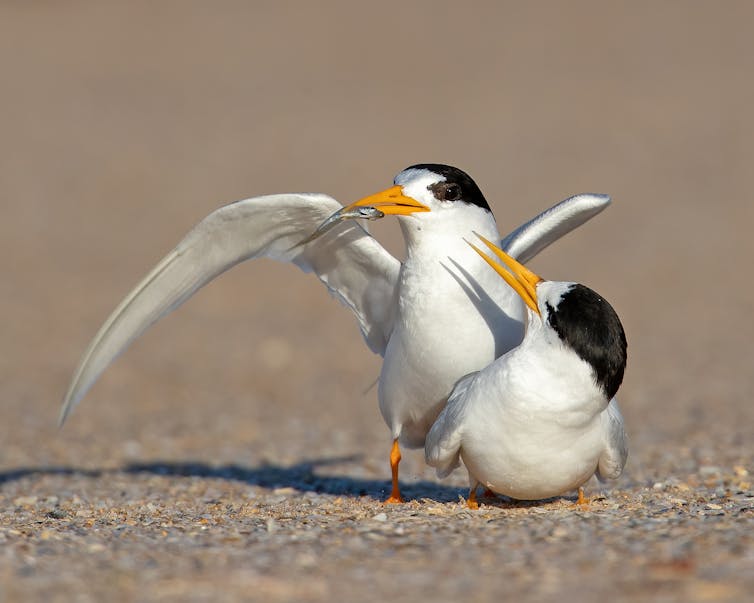 Australian fairy tern pair. Males feed female mates, helping to supplement nutrients and energy for egg production.
Claire Greenwell
Australian fairy tern pair. Males feed female mates, helping to supplement nutrients and energy for egg production.
Claire Greenwell
Fox predation and flooding from tidal inundation wiped out several colonies. Unfathomably, a colony was also lost after a four-wheel drive performed bog-laps in a sign-posted nesting area. Unleashed dogs chased incubating adults from their nests, and photographers entered restricted access sites and climbed fragile dunes to photograph nesting birds.
These human-related disturbances highlight the need for ongoing education. So let’s take a closer look at the issue, and how communities and individuals can make a big difference.
Nesting on the open beach
Beach-nesting birds typically breed, feed and rest in coastal habitats all year round. During the breeding season, which varies between species, they establish their nests above the high-water mark (high tide), just 20 to 30 millimetres deep in the sand.
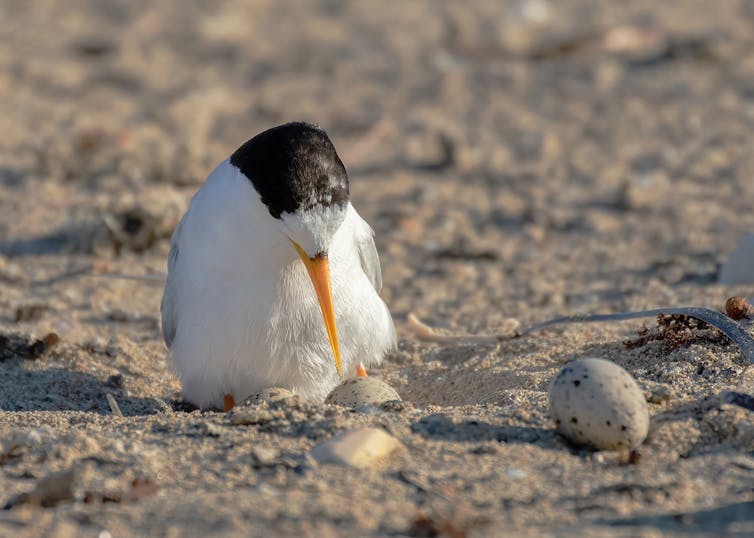 Eggs are sandy coloured and have a mottled appearance, which help them to blend in with the environment.
Claire Greenwell
Eggs are sandy coloured and have a mottled appearance, which help them to blend in with the environment.
Claire Greenwell
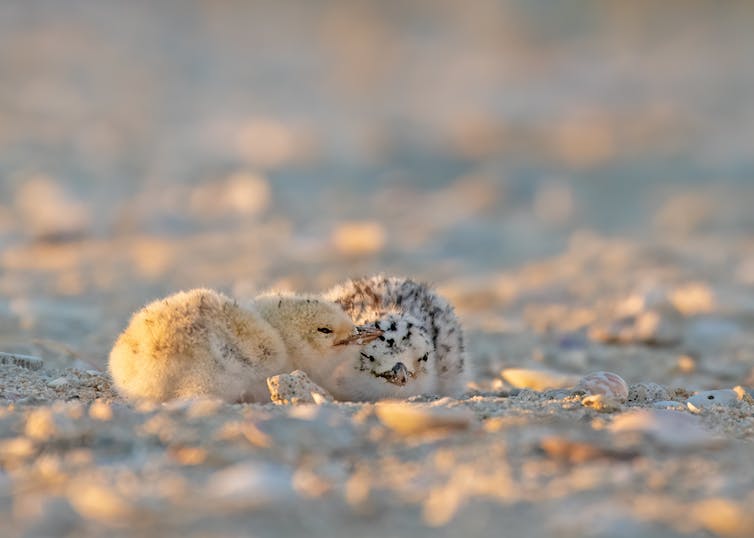 Fairy tern chicks crouch close to the ground to hide from predatory birds. Down feathers are lightly coloured and mottled to help increase camouflage.
Claire Greenwell
Fairy tern chicks crouch close to the ground to hide from predatory birds. Down feathers are lightly coloured and mottled to help increase camouflage.
Claire Greenwell
Some species, such as the fairy tern, incorporate beach shells, small stones and organic material like seaweed in and around the nest to help camouflage their eggs and chicks so predators, such as gulls and ravens, don’t detect them easily.
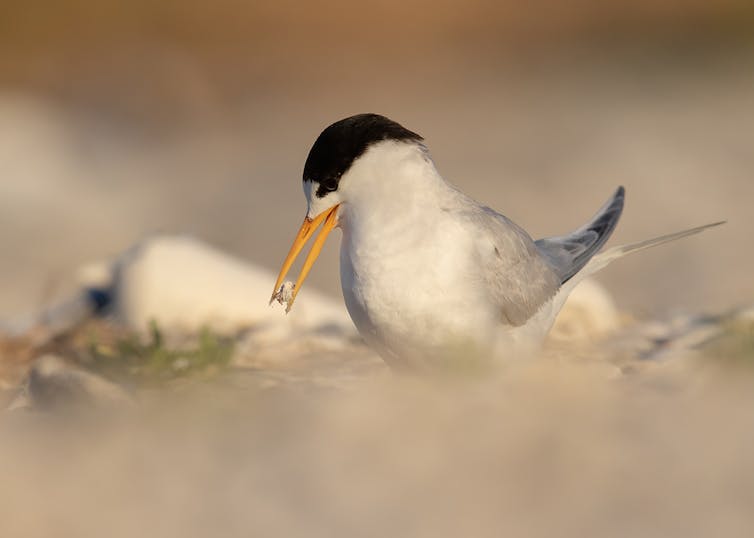 An adult fairy tern moving shell material around the nest site to increase the camouflage of its eggs.
Claire Greenwell
An adult fairy tern moving shell material around the nest site to increase the camouflage of its eggs.
Claire Greenwell
While nests are exposed and vulnerable on the open beach, it allows the birds to spot predators early and to remain close to productive foraging areas.
Still, beach-nesting birds live a harsh lifestyle. Breeding efforts are often characterised by low reproductive success and multiple nesting attempts may be undertaken each season.
Eggs and chicks remain vulnerable until chicks can fly. This takes around 43 days for fairy terns and about 63 days for hooded plovers (Thinornis rubricollis rubricollis).
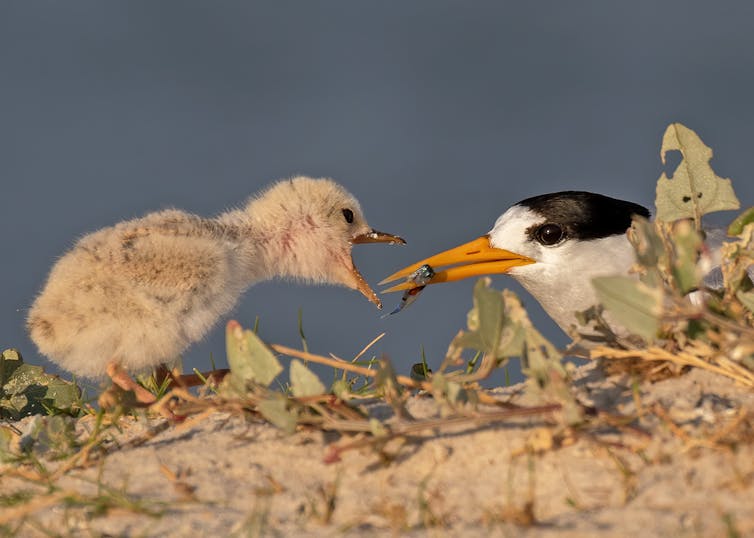 Eggs and chicks are vulnerable until chicks are capable of flight.
Claire Greenwell
Eggs and chicks are vulnerable until chicks are capable of flight.
Claire Greenwell
Disturbances: one of their biggest threats
Many historically important sites are now so heavily disturbed they’re unable to support a successful breeding attempt. This includes the Leschenault Inlet in Bunbury, Western Australia, where fairy tern colonies regularly fail from disturbance and destruction by four-wheel drives.
Species like the eastern hooded plover and fairy tern have declined so much they’re now listed as “vulnerable” under national environment law. It lists human disturbance as a key threatening process.
Read more: One cat, one year, 110 native animals: lock up your pet, it's a killing machine
Birds see people and dogs as predators. When they approach, nesting adult birds distance themselves from the nest and chicks. For example, terns typically take flight, while plovers run ahead of the threat, “leading” it away from the area.
When eggs and chicks are left unattended, they’re vulnerable to predation by other birds, they can suffer thermal stress (overheating or cooling) or be trampled as their cryptic colouration makes them difficult to spot.
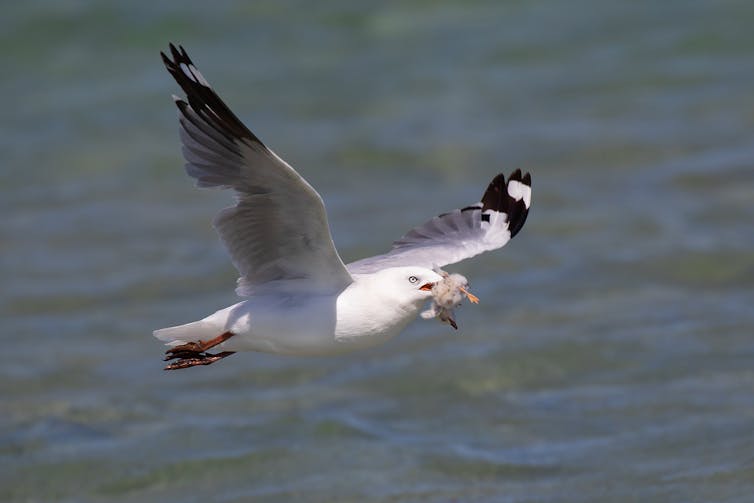 Natural predators such as silver gulls readily take eggs and chicks when left unattended.
Claire Greenwell
Natural predators such as silver gulls readily take eggs and chicks when left unattended.
Claire Greenwell
Unlike plovers and oystercatchers, fairy terns nest in groups, or “colonies”, which may contain up to several hundred breeding pairs. Breeding in colonies has its advantages. For example, collective group defence behaviour can drive off predatory birds such as silver gulls (Chroicocephalus novaehollandiae).
However, this breeding strategy can also result in mass nesting failure. For example, in 2018, a cat visiting a colony at night in Mandurah, about 70 km south of Perth, killed six adults, at least 40 chicks and led to 220 adult birds abandoning the site. In other instances, entire colonies have been lost during storm surges.
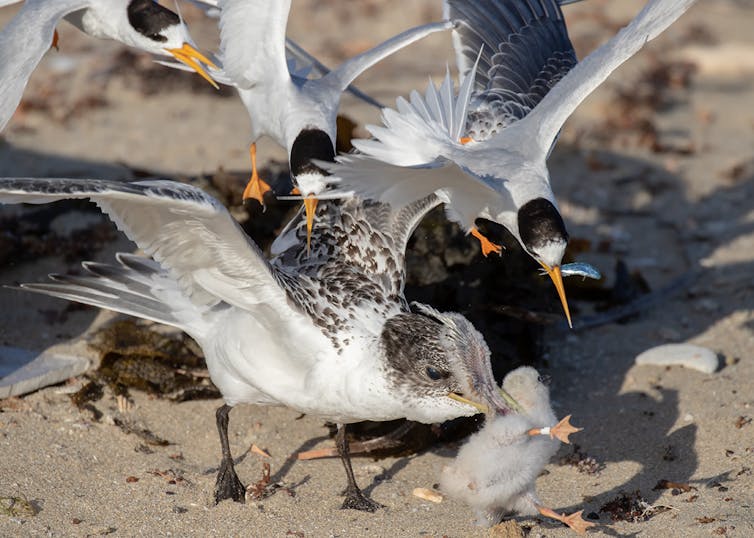 Adult fairy terns engaged in group defence or ‘mobbing’ to drive away a juvenile crested tern from a colony.
Claire Greenwell
Adult fairy terns engaged in group defence or ‘mobbing’ to drive away a juvenile crested tern from a colony.
Claire Greenwell
Small changes can make a big difference
Land and wildlife managers are becoming increasingly aware of fairy terns and the threats they face. Proactive and adaptive management combined with a good understanding of early breeding behaviour is helping to improve outcomes for these vulnerable birds.
Point Walter, in Bicton, WA, provides an excellent example of how recreational users and beach-nesting birds can coexist.
Point Walter, 18 km from Perth city, is a popular spot for picnicking, fishing, kite surfing, boating and kayaking. It’s also an important site for coastal birds, including three beach-nesting species: fairy terns, red-capped plovers and Australian pied oystercatchers (Haematopus longirostris).
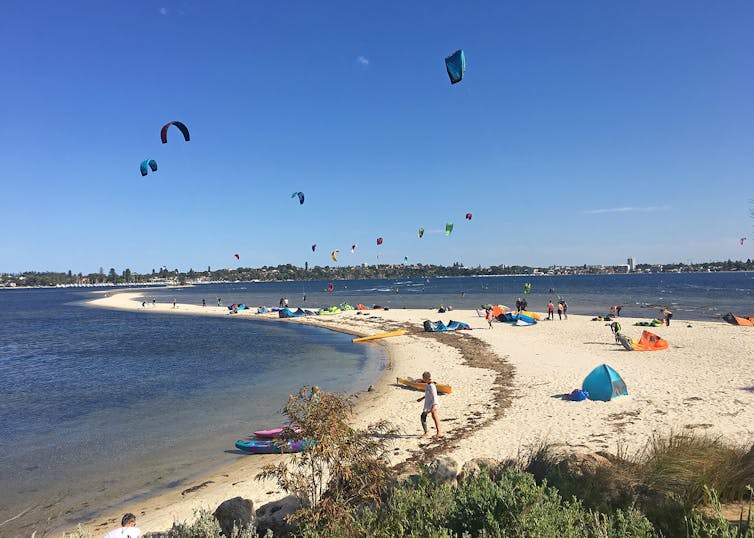 Point Walter is a popular recreational site in Perth. Recent effective management, including seasonal closures, have enabled fairy terns, red-capped plovers and Australian pied oystercatchers to nest at the end of the sand bar.
Claire Greenwell
Point Walter is a popular recreational site in Perth. Recent effective management, including seasonal closures, have enabled fairy terns, red-capped plovers and Australian pied oystercatchers to nest at the end of the sand bar.
Claire Greenwell
The end of the sand bar is fenced off seasonally, and as a result the past six years has seen the number of terns increase steadily. For the 2020-2021 season, the sand bar supported at least 150 pairs.
The closure also benefits the local population of red-capped plovers and Australian pied oystercatchers, who nest at the site each year.
 Fairy tern brooding (sitting on) its chick.
Claire Greenwell
Fairy tern brooding (sitting on) its chick.
Claire Greenwell
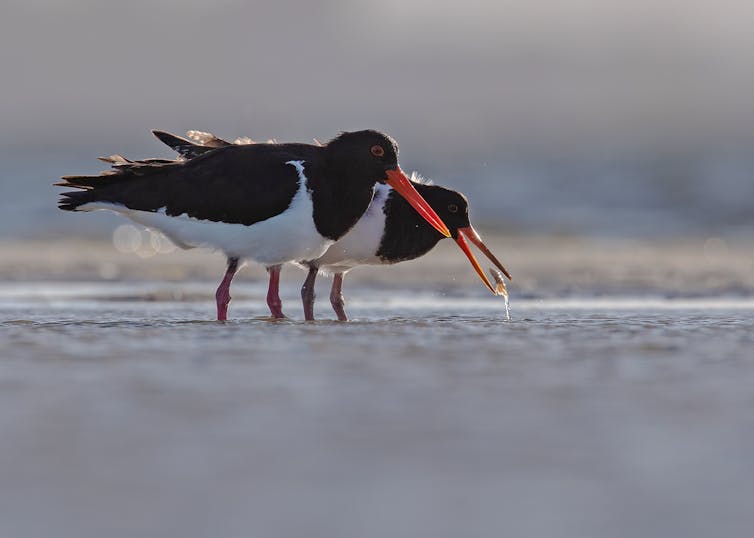 An adult Australian pied oystercatcher teaching its offspring to hunt for prey.
Claire Greenwell
An adult Australian pied oystercatcher teaching its offspring to hunt for prey.
Claire Greenwell
What’s more, strong community stewardship and management interventions by the City of Mandurah to protect a fairy tern colony meant this season saw the most successful breeding event in more than a decade — around 110 pairs at its peak.
Interventions included temporary fencing, signs, community education and increased ranger patrols. Several pairs of red-capped plovers also managed to raise chicks, adding to the success.
These examples highlight the potential for positive outcomes across their breeding range. But intervention during the early colony formation stage is critical. Temporary fencing, signage and community support are some of our most important tools to protect tern colonies.
So what can you do to protect beach-nesting birds?
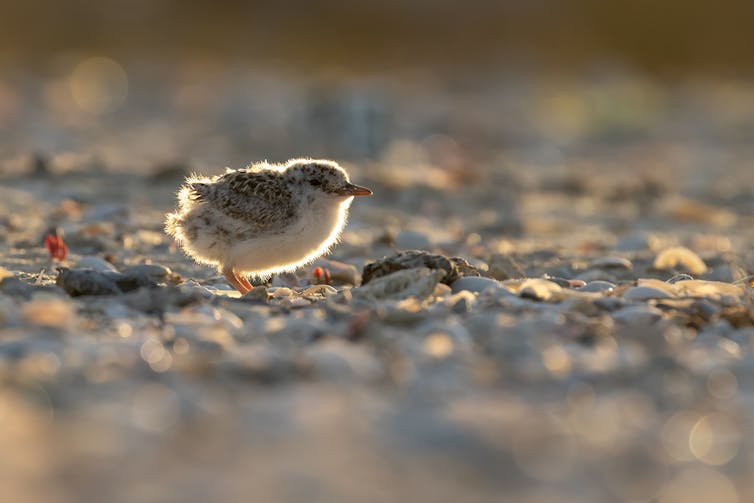 A fairy tern chick at a site dedicated to fairy tern breeding.
Claire Greenwell
A fairy tern chick at a site dedicated to fairy tern breeding.
Claire Greenwell
share the space and be respectful of signage and fencing. These temporary measures help protect birds and increase their chance of breeding success
keep dogs leashed and away from known feeding and breeding areas
avoid driving four-wheel drive vehicles on the beach, particularly at high tide
keep cats indoors or in a cat run (enclosure)
if you see a bird nesting on the beach, report it to local authorities and maintain your distance
avoid walking through flocks of birds or causing them to take flight. Disturbance burns energy, which could have implications for breeding and migration.
Read more: Don't let them out: 15 ways to keep your indoor cat happy
Authors: Claire Greenwell, PhD Candidate, Murdoch University



















